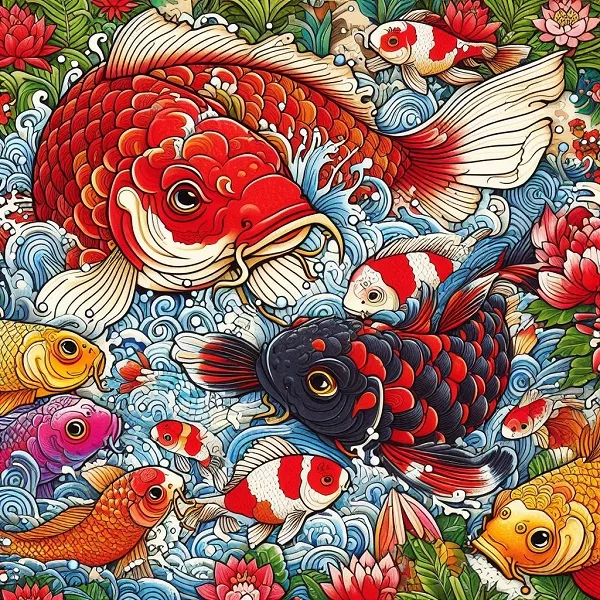
Introduction
When it comes to symbolism and cultural significance, the Koi fish holds a special place in many hearts. In some cultures, particularly in Asia, different colors of Koi are associated with various family members. This fascinating tradition is a testament to the rich tapestry of meanings that have been woven into the world of these beautiful fish. In this article, we will dive into the symbolism of different Koi colors, exploring how they represent family members and symbolize a harmonious family.
The Black Koi – The Father Figure
The black Koi fish, often referred to as “Magoi,” is a symbol of the father within the family. Black represents masculinity, strength, and experience. In many cultures, the father is seen as the protector and provider for the family, much like the black Koi is for the pond. This deep and majestic color signifies wisdom and maturity, which are the hallmarks of a strong patriarch.
The Red Koi – The Motherly Love
The red Koi, or “Beni-goi,” symbolizes the mother in the family. Red is a color that represents love, passion, and nurturing care. The mother is the heart of the family, providing warmth, love, and guidance to her children, much like the red Koi brings a sense of vibrancy and life to the pond. The red Koi beautifully embodies the nurturing spirit of a mother.
The Smaller Koi – The Children
In this familial analogy, the smaller Koi represent the children within the family. These young and vibrant fish symbolize the future and the hope that comes with it. Just as the children bring joy and vitality to a family, the smaller Koi bring a sense of playfulness and innocence to the pond, symbolizing a harmonious family unit.
The Golden Koi – Prosperity and Success
Golden Koi, or “Ogon,” symbolize prosperity and success. Within the family, they represent the dreams and aspirations that parents have for their children. Much like the shimmering scales of the Golden Koi, parents hope for a bright and prosperous future for their offspring, ensuring the family thrives.
The White Koi – Purity and Innocence
White Koi, or “Yamabuki,” represent purity and innocence within the family. Children, in their innocence, are like a blank canvas, and it is the responsibility of parents to guide them towards the right path. The white Koi reflects this innocence and the importance of nurturing it.
The Blue Koi – Peace and Tranquility
The blue Koi, or “Asagi,” symbolizes peace and tranquility. In the family context, this Koi represents the harmonious environment that parents strive to create for their children. It signifies the calm and serene atmosphere that is essential for the well-being of every family member.
The Orange Koi – Courage and Determination
The orange Koi, or “Orenji,” embodies courage and determination. Just as children need the courage to face the world and pursue their dreams, the orange Koi symbolizes this adventurous spirit within the family.
The Multicolored Koi – Diversity within the Family
Multicolored Koi, also known as “Kawarimono,” represent the diversity within a family. Every member is unique, with their strengths and weaknesses, and this diversity is what makes a family strong and vibrant. Much like the multicolored Koi, families are a beautiful mix of personalities and attributes.
Conclusion
In some cultures, the symbolism of Koi colors serves as a unique way of acknowledging the roles and dynamics within a family. From the protective fatherly black Koi to the nurturing red motherly Koi and the hopeful smaller Koi children, each color tells a story of familial love and harmony.
Koi fish not only add aesthetic beauty to ponds but also carry deep meanings, reminding us of the values and qualities that bind a family together. So, the next time you gaze at a pond of colorful Koi, remember that these graceful fish symbolize more than just beauty; they symbolize the essence of a harmonious family.
FAQs
1. Are there any other Koi colors with specific family associations?
Yes, in different cultures, there might be variations in the specific colors associated with family members, but the general symbolism remains similar.
2. Can you keep Koi fish in a home aquarium?
Koi fish are best suited for outdoor ponds due to their size and need for ample space to thrive.
3. Do all cultures associate Koi with family symbolism?
No, the association of Koi with family members is primarily rooted in Asian cultures, particularly in Japan.
4. How do you take care of Koi fish in a pond?
Proper care involves maintaining water quality, providing a balanced diet, and protecting them from predators.
5. Can the color of Koi change over time?
Yes, the color of Koi can change or intensify as they grow and age, making them even more fascinating to observe in a pond. learn more about koi fish meaning